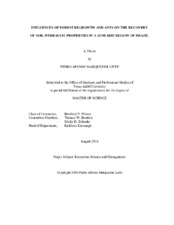| dc.description.abstract | Dryland tropical forests are at risk globally because of accelerated deforestation and the consequent losses of hydrological functions. The Caatinga shrublands in Brazil, for example, are dry tropical forests undergoing rapid deforestation, which is often followed by conversion to pasturelands. When overgrazed, these pastures become degraded and are often abandoned, allowing forests to regrow. Studies in the humid tropics have shown that natural regrowth of forest promotes a gradual recovery of soil hydraulic properties and also protect the soil against erosion. One of the mechanisms through which forests might improve soil structure is by the promoting the activity of ecosystem engineers, such as ants. However, there are some knowledge gaps in the literature of tropical dry forests about the effects of forest regrowth on the recovery infiltration and soil loss, as well as on the effects of ants on infiltration.
Soil hydraulic properties and soil erosion were evaluated on a secondary succession continuum in the Caatinga. Rainfall simulation was used to assess infiltrability and susceptibility to erosion, and saturated hydraulic conductivity was determined in the field and in the laboratory using two different methods. A relation between forest age and erosion was not found. However, there was gradual increase of hydraulic conductivity with increasing forest age, and infiltrability was only higher at the older forested site. The results suggest that a complete recovery of soil hydraulic properties might take several decades.
Soil modifications by fauna can critically affect water infiltration, which is particularly important on dryland ecosystems. Modification of soil hydraulic properties by two ant species in the Caatinga– one found at preserved forest and the other at a degraded pasture– were evaluated. Soil bulk density, texture, and infiltration were assessed on their nests and on non-nest soils. Both ants significantly modified these soil properties, but while modifications by the forest species might increase soil water available to plants, the other species had an overall negative effect on soil hydraulic properties. Such modifications could be impacting forest resilience and recovery in opposite ways. | en |


